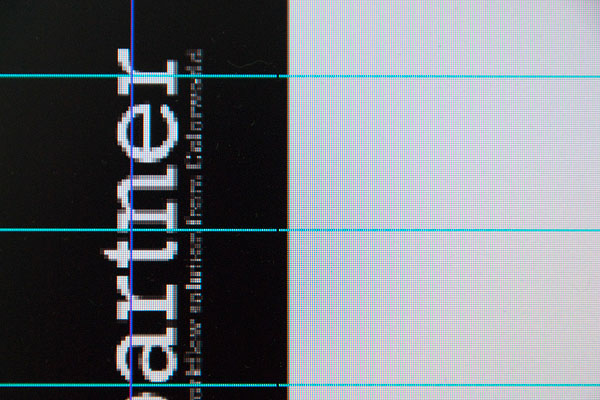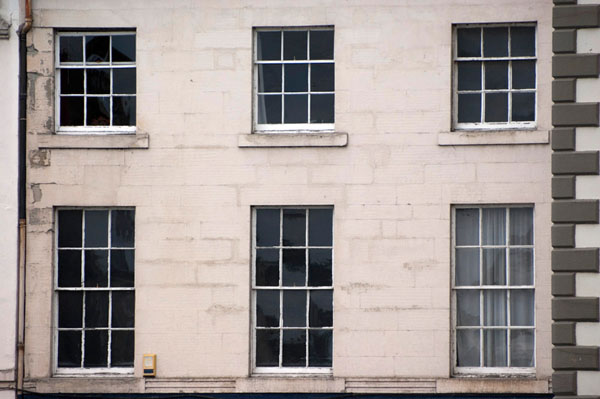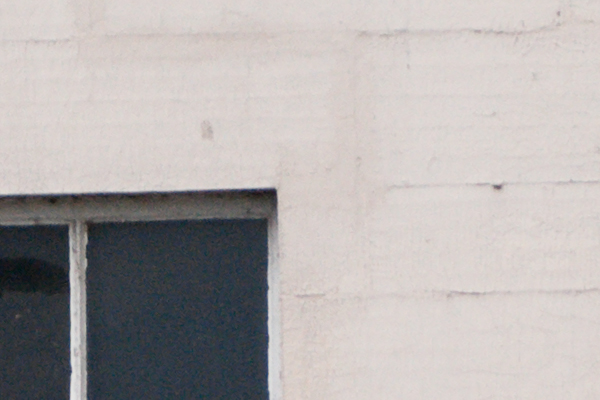Sigma 18-250mm f/3.5-6.3 DC OS HSM
Performance in practice

Sigma’s own MTF chart for the extremes of the lens range tells a very clear story – the lens is ‘better’ at the long end. The red (10 cycles = coarse detail, high contrast) sagittal and meridional lines indicate really good performance with larger image structures at both 18mm and 250mm. The green (30 cycles = fine detail, low contrast) indicates how well fine detail like grass texture, skin, hair and similar things will be resolved. I find Sigma’s chart explanation slightly confusing, as I would normally expect this test to be performed with radial and tangential lines. What you actually see here with the green dotted lines in particular is a slightly different focus point applying to lines running diagonally one way, and those running the other. This is normally caused by residual coma and astigmatism, common off-axis aberrations. Since real subjects are three-dimensional the result is most visible on test charts, least in real life.
That over-simplified short throw focus scale hides an excellent macro range, to 1:3.4X. It beats the Sony design for close ups, but it’s not just a matter of distance and scale. The Sigma has some truly unexpected qualities, which overturn everything we have seen in superzooms before now. One of these is almost perfect straight-line geometry for the closest focus at 250mm.

This is a shot of an LCD screen (iMac 24 inch) and those blue lines are the rules on an InDesign page. This is minimum focus, wide open, 250mm. Frankly, it’s amazing. It is not critically sharp but it’s as even as you could possibly want across the field, meaning the focus field is flat. The geometry is nearly perfect. You could copy stamps with this lens (for stamp-copying purposes, as a professional stamp-copier!). But, of course, you don’t spend all your time focused approximately one hand-span away from the front element. That 45cm close focus is measured from the film plane. From the viewfinder eyepiece to the front of the lens hood is 30cm, leaving you just 15cm clear between gear and subject.

You can also shoot at a distance and get reasonably straight lines. This is 250mm from a long way off. The building, though old, is not subsiding in such a way that the lines are all curvy and our lens has corrected them. You will see a hint of pincushion on the short edges (further out in the field) but again almost perfect rendering 7mm out from the lens axis (the long edge). It’s not totally straight, and has a complex distortion pattern meaning that further into the frame pincushion reappears (see the top of the upper windows, compared to the string at the bottom).
But compared to most superzooms, it’s got very straight geometry indeed – no worse at 18mm than others, and considerable better at longer focal lengths.
It also has good bokeh (rendering of the out of focus image) compared to other lenses of this range (and, an addition to this article a few months on, this Scottish thistle shot has earned me a the price of a decent 12-year-old island malt):

Guess the working aperture? Wide open? No – f/9. Again, this is at 250mm – 1/160th at ISO 200 on the Alpha 700. I have used both the Sony and Tamron 18-250mms for close-ups, and the Sigma simply does it better. It has no field curvature issues, and whatever aperture shape it happens to offer, it produces a very good bokeh. I first encountered this testing the lens on the Canon EOS 500D. I got the first sample of the 18-250mm, before even dPreview had it (the same one as it happens, we had it for a few days before it was sent on to them) and I was asked not to publish results before dPreview or Amateur Photographer, so it had to be included in tests of the camera, not as a lens test.
On the smaller Canon 1.6X sensor this lens will naturally perform better – the 1.5X sensor, of course, presses it a bit harder for vignetting, disortion and sharpness to the corners. This is something which many reviewers forget about when they choose Canon APS-C bodies for reviewing lenses, they are not getting the full picture. Here is a Canon shot:

This was at f/8, when the cherry blossom was out – tells you how long ago I got the first sample! Then we waited for the Sony HSM version to come out, and we have been using it for over a month before finally reporting here on the conclusion. We made a mistake – the lens arrived one day before Shirley and I flew to Venice for a week’s fairly intensive stock shooting. I use a range of lenses, but Shirley prefers to use just the 18-250mm. We got the Sigma out, and she was put off by the size. It was also not going to fit in our single cabin bag (a rolling Kipling camera case sized exactly for airlines) as comfortably. She opted to take the Sony instead.
The week after, processing the Venice shots and testing the Sigma, it was clear that we should have taken it, not the Sony. Whenever the Sony was used at f/6.3 and the long end, results were likely to be too soft to pass quality standards for stock libraries. The Sigma, in contrast, is dead sharp in the centre at 250mm and f/6.3 – it does not need stopping down to f/8 like the Sony.
Here is the centre detail at f/6.3 from the building shot used above to show geometry, hand-held with OS at 1/400th, ISO 200, Alpha 700, autofocus, given +1 exposure boost in conversion as it was pretty dull:

Now you may say – that’s not impressive. Remember, this is extremely low contrast very fine detail, visible in the tiny cracks of the paintwork. It’s got normal capture sharpening (25 in ACR) and no noise reduction. The Alpha 700 in v4 firmware is fairly noisy even at ISO 200 as the dark shadow area of the window shows, and the one-stop exposure correction emphasises that. But it’s also very sharp. I suggest you view this image on a good LCD screen, and take 20 seconds or so to look steadily at the paintwork to the right side, let your eyes get accustomed to the contrast. You will see clearly resolved detail at the very limit of pixel sharpness.

Here is the extreme bottom left corner (actually cropped off the full image shown earlier, which was straightened up a slight amount to align the straight masonry string with the frame edge. You can see it is rougher, as you would expect, and fairly strong CA correction has been applied – +50 Red/Cyan, with -28 Blue/Yellow, and Defringe all Edges. The result of a straight process with no CA correction shows the exact extent of the strongest colour fringes given by the Sigma:

Note that the green fringe is very sharply defined. When CA is lateral (off-axis chromatic aberration, blue/red extreme wavelengths form smaller/larger images in the same focal plane) more than longitudinal (same wavelengths for same sized images, but focus in front of/behind the focal plane) a very clean post-process correction is possible.

OK – time has come to decide between new lenses for the A77 that is on order –
Sigma 18-250 OS HSM or Tamron 18-270 Pz motor?
I managed to take some more shots today, did some experimenting with
aperture and ISO settings. Double checked that OS was off and SSS on.
I took a number of pictures in the f8 – 11 range. 18mm, 250mm and a few macro shots. For the macro shots, I tried both manual and Scene/Macro settings, didn’t make any difference that I noticed. I tried the f11-16 range.
I hate to say it, but I am not impressed.
The image quality at low ISO (800 and below) is about the same as my P&S up to about ISO 200; but going to higher f numbers forced me as high as 1600 ISO …in bright daylight. So stopping down the aperture starts to cut into the advantage of the better ISO noise.
Macro IQ is definitely better on the P&S.
I do see some stunning images on the web from this setup, but right now I’m thinking there may be a lot of PP involved. I certainly never came close to “stunning”.
This being a lens review article, I feel a bit guilty bringing the camera body into it, but I can’t really separate out whether it is a limitation of the lens or the body. I concede it may be me, but I sure don’t see what I’m doing wrong.
I really was hoping for better low light performance (got it), more features (got those), and better IQ both in good light(nope) and macro (nope).
I’m pretty disappointed. I did a lot of research and this combination came out as about the best all-round setup I could find. I really wanted it to knock my socks off … but I think it goes back in the box and back to the dealer.
I don’t know whether to bother trying one of the other manufacturers, or whether to give up on the superzoom idea and go to lens swapping.
Or maybe just forget DSLR’s altogether.
Anyway, thanks for your help David. I’m glad the lens/camera works for you, I guess maybe I just had unrealistic expectations.
Thanks for the quick reply and the tips David!
It’s raining here in southern NH/USA so I can’t get out and do test shots right now, but as soon as I can I will and will get back to you.
Your tips about aperture may be the issue; the quick shots I did last night were as wide open as the lens settings would allow; so maybe that’s the problem.
I was using SSS, with the lens OS off. I doubt I can be patient enough for that long wait for the OS to activate !
I hope I can get this IQ straightened out, other than that (which is key of course) I really like the setup.
I guess I’m looking for a sanity check. Never had aDSLR before, just bought a Sony a55 and Sigma 18-250 and am surprised at the relatively poor IQ compared to my Canon Sx120 P&S. I expected IQ to be better in all lighting, but so far (only a few test shots, can’t do many if I want to return it – which I think I do), disappointed.
At high ISO, the a55/Sigma is clearly superior.
At low ISO, outdoor shots in good light, both macro and wide, the Canon P&S IQ is better. Much unexpected!
Is this common, that a P&S IQ be better at low ISO?
Or maybe there is technique I’m missing … maybe just because I’m not at the ‘sweet spot’ aperture for the sigma?
Been shooting at the lowest f-stop possible. Maybe that’s bad?
Reviews for both the a55 and the Sigma are all good … so if this is as good as it gets I guess there’s no point in trying other DSLR / lens combinations 🙁
Clearly something is very wrong as the A55 image quality at low ISO is superb – and the Sigma is the best lens of its type. First of all, the Sigma is generally at its best around f/8 to f/11 on the A55. It will not be capable of good macro shots at 250mm and f/6.3 (wide open is never sensible with any long range zoom) and the depth of field will not be sufficient for many subjects, so for macro work I would always try to use f/11 or even f/16 and move to a higher ISO. It is noise free up to ISO 1600 if processed correctly from raw, and this is very useful for macro. If you try to stop down to say f/16 or f/22 for routine work you’ll just get soft images (diffraction) and probably subject movement at low ISOs.
One thing to be absolutely sure about is the SSS setting and OS on the lens. We use the lens OS, it really helps with viewing at longer lengths. This means the SSS in the camera MUST be set to OFF in the menu. If you leave Steady Shot set to ON, you will get very unsharp images when the Sigma lens is also set to OS, the two systems will overcompensate or even work against each other and blur the image badly.
David
Thanks a lot for the review, very detailed and very interesting indeed. Did you try it on an Alpha 55 which you reviewed as well?
Thanks again for what you do David for the Alpha users.
We’ve used the 18-250mm on the A55 and our sample works well enough except for one small issue, from time to time the lens can lose contact with the camera. It needs a factory fix to be perfect because it is an early example of the lens. Service is restored by simply pressing the lens release button and briefly shoogling the lens, it seems to be a mount-fit issue nothing else.
A very interesting review….. I have the Tamron 18-200 and really loved it when I first bought the lens, but now it is starting to feel a little long in the tooth, or my photographic skills have improved! The implementation of HSM is an obvious drawcard for this lens, and thanks to your review, I might have to start saving up for it……..
Your reviews always show the users’ perspective, not just the technical jargon that you get elsewhere. The important part of how a lens performs is how if feels on the camera, and the resulting images that it takes along with how much extra work you need to put in afterwards to get the image right! To me, the less that has to be done, the better!
Thanks again!